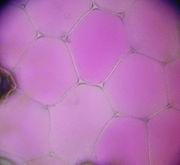what structure keeps a plant cell from exploding due to being in a hypotonic solution
| Plasmolysis | |
|---|---|
 | |
| A ruby claret cell in a hypertonic solution, causing water to motility out of the cell. | |
| Specialty | Cell biology |
| Causes | Osmosis |


Before plasmolysis (top) and after (bottom)
Plasmolysis is the procedure in which cells lose h2o in a hypertonic solution. The reverse procedure, deplasmolysis or cytolysis, tin can occur if the prison cell is in a hypotonic solution resulting in a lower external osmotic pressure and a net catamenia of water into the prison cell. Through ascertainment of plasmolysis and deplasmolysis, it is possible to determine the tonicity of the cell's surround as well every bit the rate solute molecules cross the cellular membrane.
Etymology [edit]
The term plasmolysis is derived from the Latin word 'plasma' significant 'matrix' and the Greek word 'lysis', meaning 'loosening'.
Turgidity [edit]
A plant prison cell in hypotonic solution volition absorb h2o by endosmosis, so that the increased volume of h2o in the cell will increment pressure level, making the protoplasm push against the jail cell wall, a condition known as turgor. Turgor makes plant cells push against each other in the aforementioned fashion and is the primary line method of support in non-woody plant tissue. Plant cell walls resist further water entry after a certain point, known equally full turgor, which stops plant cells from bursting equally beast cells do in the same conditions. This is likewise the reason that plants stand up upright. Without the stiffness of the plant cells the plant would fall nether its own weight. Turgor pressure allows plants to stay firm and cock, and plants without turgor pressure (known equally flaccid) wilt. A cell will begin to refuse in turgor pressure merely when at that place is no air spaces surrounding it and somewhen leads to a greater osmotic pressure than that of the prison cell.[i] Vacuoles play a role in turgor pressure when water leaves the cell due to hyperosmotic solutions containing solutes such as mannitol, sorbitol, and sucrose.[ii]

Found cell undergoing Plasmolysis in a Hypertonic solution (x400 magnification)
Plasmolysis [edit]

Plant cell under different environments
If a plant cell is placed in a hypertonic solution, the constitute prison cell loses water and hence turgor pressure by plasmolysis: force per unit area decreases to the point where the protoplasm of the jail cell peels abroad from the jail cell wall, leaving gaps betwixt the cell wall and the membrane and making the establish jail cell shrink and crumple. A connected subtract in pressure eventually leads to cytorrhysis – the complete collapse of the cell wall. Plants with cells in this status wilt. Afterward plasmolysis the gap between the jail cell wall and the cell membrane in a plant cell is filled with hypertonic solution. This is because as the solution surrounding the cell is hypertonic, exosmosis takes identify and the space between the cell wall and cytoplasm is filled with solutes, every bit about of the water drains away and hence the concentration inside the cell becomes more hypertonic. There are some mechanisms in plants to preclude excess water loss in the same way as excess water gain. Plasmolysis tin can be reversed if the cell is placed in a hypotonic solution. Stomata aid keep water in the plant so it does not dry out. Wax likewise keeps water in the plant. The equivalent process in animal cells is called crenation.
The liquid content of the cell leaks out due to exosmosis. The cell collapses, and the cell membrane pulls away from the cell wall (in plants). Most fauna cells consist of but a phospholipid bilayer (plasma membrane) and not a cell wall, therefore shrinking up nether such conditions.
Plasmolysis simply occurs in farthermost conditions and rarely occurs in nature. Information technology is induced in the laboratory by immersing cells in strong saline or sugar (sucrose) solutions to cause exosmosis, oftentimes using Elodea plants or onion epidermal cells, which have colored cell sap then that the procedure is clearly visible. Methylene blueish tin can exist used to stain found cells.
Plasmolysis is mainly known as shrinking of prison cell membrane in hypertonic solution and peachy pressure.
Plasmolysis can be of 2 types, either concave plasmolysis or convex plasmolysis. Convex plasmolysis is always irreversible while concave plasmolysis is usually reversible.[two] During concave plasmolysis, the plasma membrane and the enclosed protoplast partially shrinks from the cell wall due to half-spherical, inwarding curving pockets forming betwixt the plasma membrane and the cell wall. During convex plasmolysis, the plasma membrane and the enclosed protoplast shrinks completely from the jail cell wall, with the plasma membrane's ends in a symmetrically, spherically curved pattern.[2]
References [edit]
- ^ Munns, Rana (2010). Plants in Action. Australian Gild of Plant Scientists.
- ^ a b c Lang, Ingeborg; Sassmann, Stefan; Schmidt, Brigitte; Komis, George (2014). "Plasmolysis: Loss of Turgor and Beyond". Plants (Basel, Switzerland). 3 (4): 583–93. doi:ten.3390/plants3040583. PMC4844282. PMID 27135521.
External links [edit]
- Pictures of plasmolysis in Elodea and onion pare. Archived April 16, 2008, at the Wayback Auto
- Wilting and plasmolysis. Archived October fourteen, 2007, at the Wayback Machine
Source: https://en.wikipedia.org/wiki/Plasmolysis
0 Response to "what structure keeps a plant cell from exploding due to being in a hypotonic solution"
Postar um comentário